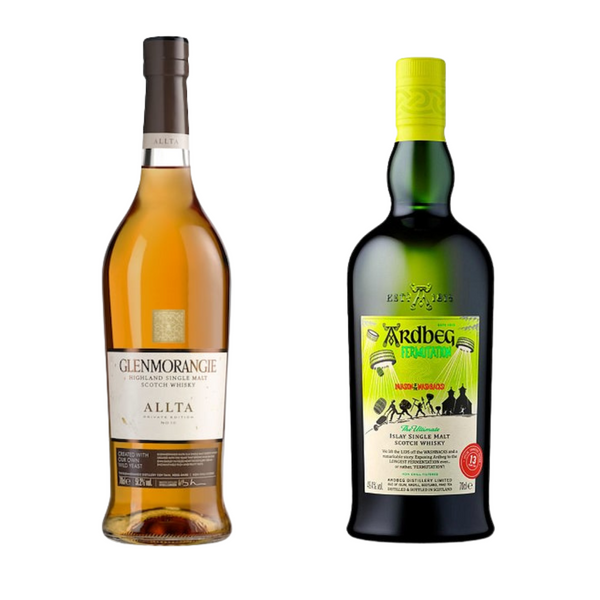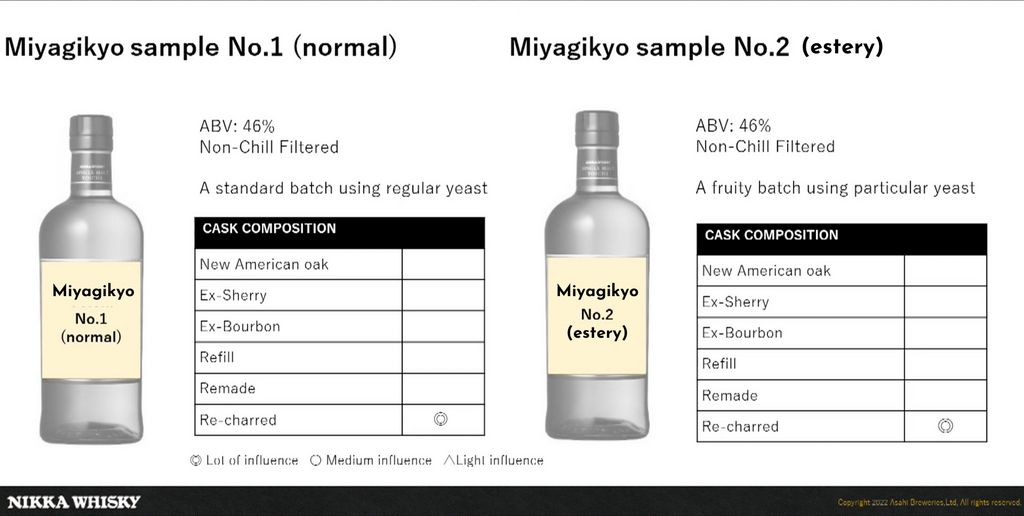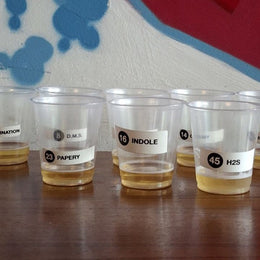Click here to read our review of the Nikka Discovery Aromatic Yeast single malt set. All masterclass materials reproduced are courtesy of Nikka Whisky Distilling Co. Ltd.

When I first started drinking whisky, I quickly learnt that there are three main “levers” in the whisky-making process that could change the way a whisky could taste. Cask style is an obvious factor – the spirit could be flavoured by American oak, European oak or even Mizunara, previously holding Sherry, bourbon, rum, brandy, red wine or even India Pale Ale. Presence of peat too is an important factor – giving the spirit varying degrees of smokiness. We also have the size and shape of the pot stills, which affects the weight and texture of the distilled spirit à la Macallan’s tiny round stills, or Glenmorangie’s Giraffe-tall stills.
This was but the tip of the iceberg.
In recent years, Scotch makers have begun recognising that yeast fermentation is a new frontier for the whisky industry, offering many more possible flavour pathways. In 2019, Glenmorangie proudly presented its Allta single malt which is made using a mash of barley harvested from a particular field in Tain, fermented with the same strain of wild yeast present in the barley field. This year, its sister distillery Ardbeg released the Ardbeg Fermutation which explores how extended fermentation of 3 weeks would introduce unusual flavours to a Ardbeg.


Yeast is also taken seriously in Dornoch Distillery, which uses over 30 different varieties of brewers’ yeast (instead of high alcohol yield distillers’ yeast) to create complex, fruity flavours in their single malts. Specific esters were isolated to obtain specific notes of tropical fruits sought by the Thompson Bros who run Dornoch.
Yet the Scotch industry is comparatively late to the yeast party compared to the Japanese. For several decades, Japanese whisky giant Nikka has been developing a vast reserve of proprietary yeast cultures from various sources. According to Nikka whisky’s chief blender Tadashi Sakuma, of these hundreds of proprietary strains, about 10 of these yeast strains are commonly used in whisky making.
In contrast, Scotch makers traditionally considered yeast as a functional tool, not a flavouring tool, and always using the same neutral strain of distillers’ yeast for decades (until recent years). As Sakuma highlighted in several interviews, Scotch producers prefer to create a variety of flavours in whisky by smoking malt with peat, or exchanging whiskies across distilleries to create a blended whisky. On the other hand, Japan has been a whisky oligopoly with only a small handful of distilleries for the last two generations. This led them to develop ways to produce various different types of whisky in-house, including the development of their own yeast strains.
During Whisky Live Singapore 2022, we had the chance to taste for ourselves the effects of Nikka’s proprietary yeast strains on whisky.

We began with an introduction to the Nikka Discovery Series Aromatic Yeast range from Yoichi Distillery and Miyagikyo Distillery. If you haven’t already heard of it, Nikka’s Discovery Series began last year and is an annual instalment of whiskies leading to their 90th Anniversary in 2024. The Discovery Series looks to explore various aspects of Nikka’s whiskymaking and some behind-the-scenes experiments that makes up their iconic Yoichi and Miyagikyo single malts. Volume 1 of the Discovery Series was focused on peat – you can find our reviews here.
How Nikka Experiments with Yeast
This year’s Volume 2 set is titled “Aromatic Yeast” which focuses on the unusual aromas that could be generated by special strains of yeast selected from Nikka’s vast reserves.

Our masterclass host was Nikka’s chief of international marketing Naoki Tomoyoshi, who explained how Japanese whisky makers experimented with yeasts in a highly systematic fashion. Since Nikka’s foundation in the 1930s, Nikka’s researchers has been meticulously sampling and collecting new yeast strains from various sources, resulting in a library of hundreds of different yeast strains. Many of these yeast strains were then used in pilot trials to make experimental whisky batches. Finally, blenders would periodically evaluate the spirit – whether new make or well-matured – to determine the flavouring potential of each strain of yeast.

Over the years, this meticulous process has helped Nikka narrow down and identify 10 specific strains of yeast that have good potential in whisky-making.
Nikka Aromatic Yeast were originally from unusable experimental batches
Given the large number of experimental batches created from unusual strains of yeast, there are bound to be batches that don’t taste great initially.
Here’s where the Aromatic Yeast set comes in. This set consists of many experimental whisky batches that Nikka blenders did not appreciate as new make – because very unusual strains of yeast were used. However, after years of maturation, these batches were recently re-evaluated to have the potential to make good quality whisky of an unusual style.
While the exact strains of yeast used are Nikka’s closely guarded trade secrets, this masterclass offered us the rare opportunity to have a peep at the blender’s creative process in blending whiskies at Nikka from unusual strains of yeast.
Tasting time

We were offered glasses of the Yoichi Aromatic Yeast and Miyagikyo Aromatic Yeast, together with 6 glasses of non-commercially released whiskies used by blenders to make these expressions. Most of these samples range from about 9 to 10 years old, with the exception of an extremely rare 40-year-old Miyagikyo which I couldn’t stop talking about.
We began with a pair of Yoichi samples.


Yoichi No. 1 was made with what the masterclass referred to as “regular yeast” – which is presumably Nikka’s preferred proprietary yeast strain for their whiskies. This dram has a familiar malt sweetness, richness, oily texture and light peatiness that is reminiscent of a typical Highland Scotch, and the NAS Yoichi Single Malt.
This is paired with Yoichi No. 2 which is made with an atypical strain of yeast. The overall flavour elements are similar to the No.1, but there is incidentally no peatiness in this, making this feel similar in character to the Non-peated Yoichi from the Nikka Discovery series. But interestingly, the use of this atypical yeast strain seems to make this significantly sweeter and fruitier with heightened notes of caramel candy and pear drops.


Moving on to the Miyagikyo.
We had a taste of the Miyagikyo sample No. 1 that was made with regular yeast. Just as expected, this is full of florals on the nose and an elegant palate of soft caramel. No peatiness of course. There’s also more grassiness here, making this greener than Yoichi No. 1.
For comparison, we have the Miyagikyo sample No. 2 made with an atypical strain of yeast. This has a very bright sweetness and crisp acidity – unusual to the standard character of a Miyagikyo. This is also more sharp on the palate and slightly more estery.


Here is where things get legendary as we moved on to taste the experimental samples of Yoichi No. 3 and Miyagikyo No. 3. Naoki, the masterclass host, directed us to lift the lids covering two of the Glencairn glasses in front of us.

A fresh, tart, melon-like aroma swept through the room as we lifted the lids. “This is what our blenders call the ginjyo saké whisky,” said Naoki. And he’s absolutely right – this Yoichi sample smells so much like sweet Japanese sake. The notes from this dram really pop – it’s incredibly clean, sweet, estery with rich fermented top notes. The palate has all of the same, and is also refreshing, round and runny. You could just as well be drinking a chilled Dassai saké.
But that’s nothing compared to the Miyagikyo No. 3. Compared to the typical NAS Miyagikyo, this has a much richer and more front-and-centre notes of dried apricots, torched peaches, with depths of fragrant vanilla and even some sweet sandalwood. The palate is more of the same with added notes of fresh whipped cream. We rarely see such an intensity of peach and apricots in a single malt.
As if to validate our palate, Naoki went on to reveal that the Miyagikyo No. 3 is an incredibly rare sample of 40 year old Miyagikyo. This is some experimental stuff that was made in very small batches, and would never hit the shelves of liquor stores.
All of the Yoichi and Miyagikyo samples tasted above were components used to create the 2022 Yoichi and Miyagikyo Aromatic Yeast set.


Finally, we were allowed to taste the Aromatic Yeast set that everyone’s talking about.
Tasting the Yoichi Aromatic Yeast, we get a fruity nose with malt sweetness, with a light sourness of fermented milk products like yoghurt and Yakult. We can certainly smell some influence of the Yoichi sample No. 3 here! Peat gently reveals itself with a touch of sea spray. The palate is a nice, hefty, buttery texture, that is lightly sweet and honeyed with cereals and confectionary.
Moving on to the Miyagikyo Aromatic Yeast – we get bright uplifting scents of stone fruits and orchard fruits, light apricots and peaches combined with some dark jammy sweetness. The palate is a lot richer and has more depth than the nose. Lots of honey, red apples and more apricots, a deep fruitiness continuing in the aftertaste balanced by a mild oakiness. Like a typical Miyagikyo NAS, this has a lot of fruit, but there’s a nice one-two combo of both orchard fruits and deep jammy red fruits.
Read our full review of both Aromatic Yeast expressions here.
How Nikka’s blenders work
As mentioned earlier, the Nikka Aromatic Yeast set consists of some experimental whisky batches that Nikka blenders initially did not appreciate as new make. Creating blends from distinctive-tasting batches is a challenge.

For instance, Mr Watanuki who was in charge of developing the Yoichi Aromatic Yeast commented that the ginjo saké-like Yoichi No. 3 sample – while interesting - did not have sufficient balance, and was too “distinctive” and “unrestrained” in its flavour. In using the No. 3 to create the Yoichi Aromatic Yeast, he had to take great care to only enhance what he considers the “good aromas” of the sample.
Mr Watanabe who was in charge of developing the Miyagikyo Aromatic Yeast commented that he also faced challenges integrating the very peachy profile of the Miyagikyo No. 3 sample with other samples to create the Miyagikyo Aromatic Yeast.

Nikka’s small team of highly trained blenders – who presumably all have incredible nosing and tasting skills – review Nikka’s reserve of whiskies to create blends that become the commercially available ones on our shelves. Generally, they work inductively by picturing an ideal flavour profile, and selecting appropriate batches from their reserves to create an ideal commercial blend.
They are the most busy every June and July, during which they would be collecting samples from Nikka’s distilleries to create their blends.
Nikka 90th Anniversary
Nikka Discovery’s focus in 2021 was on mixing up ingredients used to make whisky, while the 2022 focus was on the use of yeast in the fermentation process. The team has already begun working on the third and final volume of Nikka Discovery in 2023, which anticipates 2024 – the year that marks Nikka Whisky’s 90thAnniversary.

What sort of exploration would we see in the third volume of Nikka Discovery? After we’ve been suitably impressed by this intriguing exploration of yeasts, it’s hard to imagine how Nikka could top this.
We have already seen a whisky cask switcheroo in the likes of previously-released Yoichi Sherry & Sweet, so another exploration of casks may not seem to be particularly exciting. Yet there’s more to maturation than cask styles – Nikka’s history is rooted in the fact that its founder, Masataka Taketsuru, believed that the climate of the distillery has a big impact on the resulting whisky made. I’m going to make an educated guess that we may be seeing something about maturating casks in different locations and varied climates. We’ve already seen Mars perform a similar experimentation of 4 to 5 year old Shinshu single malts matured in different Japanese climates.
Would Nikka be performing a similar act? Time will tell.

@CharsiuCharlie







